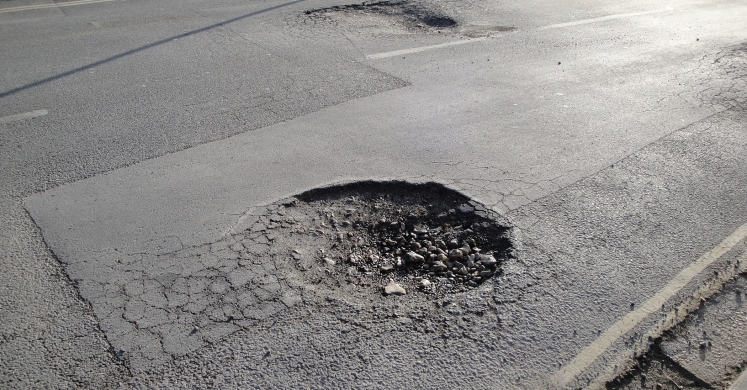Blog

#bioPGH Blog: Pavement, Potholes, and Pittsburgh’s Clay
 A resource of Biophilia: Pittsburgh, #bioPGH is a weekly blog and social media series that aims to encourage both children and adults to reconnect with nature and enjoy what each of our distinctive seasons has to offer.
A resource of Biophilia: Pittsburgh, #bioPGH is a weekly blog and social media series that aims to encourage both children and adults to reconnect with nature and enjoy what each of our distinctive seasons has to offer.
In our everyday vernacular, we tend to refer to “nature” as something separate from us humans—separate from our towns, homes, and where we work. Every now and then, though, nature finds a way to remind us that no matter how separate we think we are, we really have just changed the way we interact with our surroundings. For example, have you taken a drive through Pittsburgh recently and noticed quite a bit of potholes? Roads and driving may be human-made processes, but let’s explore a little bit of nature’s processes still leaving their mark.
One reason for all of the pot holes are freeze-thaw cycles. Contrary to the majority of materials that humans interact with, water expands in its solid phase (ice). When water seeps into the tiniest of cracks in the road and then freezes, it creates bigger cracks and nicks that crumble and break when cars and trucks drive over it. Many of us are familiar with this part of the pothole equation, but there is another reason for potholes, though, especially here in Western Pennsylvania. And that reason is what you find beneath our roads: clay.
If we go back to our discussion about soil, we remember that a soil’s texture is the proportion of sand, silt, and clay present in the total soil. Typically, sand is defined as particles that are 2 mm to 0.5 mm in diameter, clay is less than 0.002 mm, and silt is anything in between. Here in Pennsylvania, our soil has quite a bit of clay, and clay holds on to water more than the other two sizes of soil particles. Water helps the grains of clay stick to each other through adhesion, which helps clay retain moisture more than the other two texture types. This abundance of moisture-laden clay also moves a great deal during freeze thaw cycles. The wet clay can shift, expand, or pull to either side. This affects the road above it.
To help explore this concept a bit more, I talked with Studio Phipps landscape architect Mark D’Amico, who helped explain the kind of roads common here in the Pittsburgh, and why our clay soil matters.
“With our asphalt roads, the asphalt is itself a veneer over the layers of the road. The asphalt doesn’t provide any structural support. It’s all about the layers below it,” Mark says.
“The first layer is the subgrade, which is either compacted fill or undisturbed soil subgrade—this layer must be compacted to make it stable to support the road bed. Then a geotextile layer is usually placed over the subgrade to prevent clay from migrating into stone aggregate layers above. This stone aggregate layer is called the subbase, and it can be anywhere from 6-12 inches thick. These fines ‘choke’ the upper layer of the subbase to allow for tight compaction and a smooth surface to accept the asphalt pavement, which creates the road surface.”
Here is where the clay in our subgrade can become a challenge. Since our soils are dominated by clay, our roads essentially sit on top of a material that holds onto moisture quite well. When the freeze-thaws of this winter occurred, the wet clay can create what’s called frost heaves, meaning it can buckle upwards into the stone aggregate subbase, shifting the stones and leaving weak spots. Now imagine a series of heavy vehicles regularly hitting those weak spots all day long. Also, if water gets into the stone aggregate layer, and proceeds to freeze-thaw, that can also spell trouble for the pavement above.
“The clay, the freezing and thawing, it’s a really a perfect storm for the roads,” says Mark.
Now don’t worry, though—clay isn’t really a villain. It’s just part of Pennsylvania’s local natural heritage. Our prehistoric clay can even be found in our shale deposits—clay that has been intensely compacted over ages. As residents in nature, the more we learn about how our activities intersect with natural history, the better we can adapt to be denizens who work with rather than around nature. But…you should probably still get your alignment checked once it gets warm!
Connecting to the Outdoors Tip: You can explore the soil in your garden or backyard by checking out these family-friendly activities! Check out the nutrients in your own soil, learn about the importance of soil for sustainable farming, or maybe even plant your own garden!
Continue the Conversation: Share your nature discoveries with our community by posting to Twitter and Instagram with hashtag #bioPGH, and R.S.V.P. to attend our next Biophilia: Pittsburgh meeting.
Photo Credits: Wikimedia User Editor5807 CC-BY-3.0 and Pexels CC0

